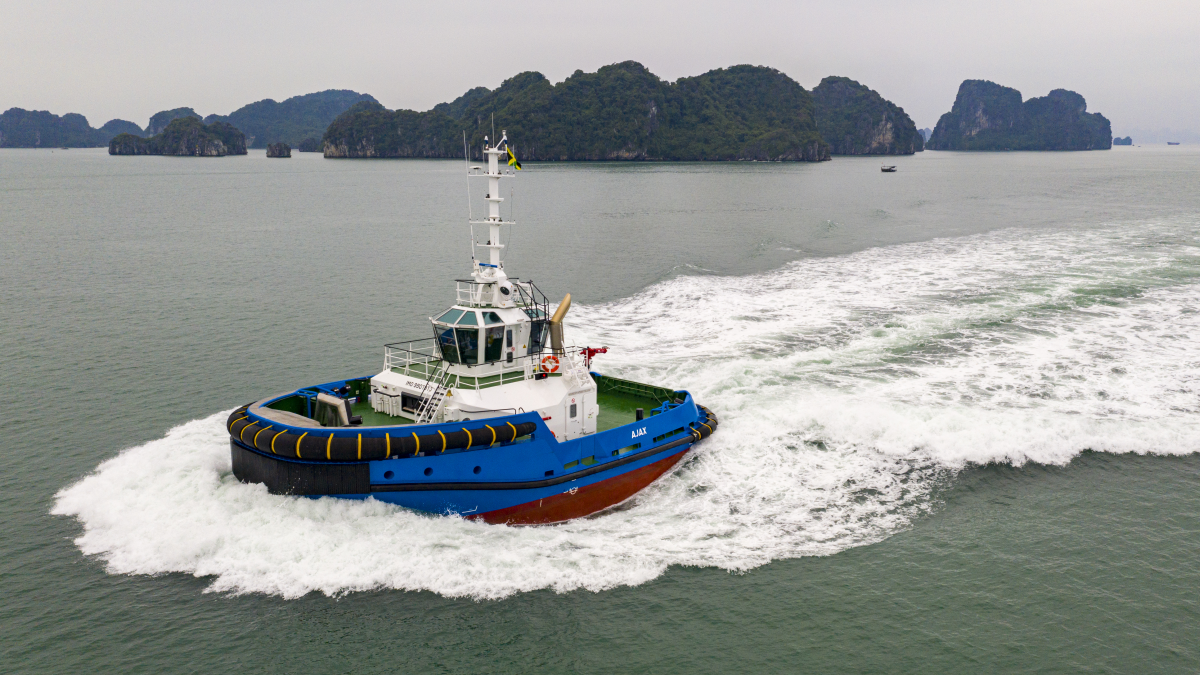
New $15m tug to ensure “always open” port
Media release - 30 May 2025
As part of Port Otago’s strategy to be New Zealand’s “always open” port and capable of handling the biggest ships visiting the country, a new 70-tonne Damen ASD* 2312 tug is on its way.
Port Otago Chief Executive Kevin Winders says the $15m tug is a key piece of infrastructure that will allow the port to be big-ship capable.
“We already have the three other essential components in place: the Multipurpose Wharf, at 430 metres long and a berth depth of 14 metres; consent to deepen the Lower Harbour channel to 15 metres; and a new state-of-the-art dredge on order. By January 2026, we will also have the tug fleet we need – that is a fleet capable of handling container vessels up to 10,000TEU^ and larger bulk ships. It’s also relevant that these bigger vessels have lower carbon footprints per container movement.”
Currently, the company’s three-tug fleet consists of:
• Tug Taiaroa (2014) – Damen 70-tonne bollard pull
• Tug Otago (2003) – 58-tonne bollard pull, and
• Tug Arihi (2016) – 30-tonne bollard pull. (Arihi’s main role is manoeuvring our backhoe dredging operation; she also provides back-up towage.)
Port Otago GM Marine and Infrastructure Grant Bicknell says that, when the Marine team assessed the tug specifications required to handle the larger vessels, the Damen ASD 2312 tug was the standout option. “Initial modelling showed our current channel design and 14-metre depth was sufficient to transit a 10,000 TEU container vessel from the Otago heads through to Port Chalmers. However, to manoeuvre the vessel in the swing basin and onto the 430-metre main container berth, the Multipurpose Wharf, required two 70-tonne bollard-pull tugs.”
The decision was made to sell Tug Otago and purchase the second 70-tonne Damen tug. Alongside the capability advantages, the upgrade also reduces the tug fleet’s maintenance risk and provides a better carbon outcome. The Damen tug’s modern Euro 6 diesel engine uses two-thirds as much fuel as the 21-year-old Tug Otago.
Grant says the Damen ASD 2312 tug is one of Damen’s most well-known vessel types. “It has excellent manoeuvrability because of its compact shape, patented Twin Fin skeg configuration and twin Azimuth thrusters.”
He says the single winch design is another feature that has both operation and safety benefits. “Older tugs have two winches – one for fore and aft – but the Damen ASD 2312 has only one centrally-placed winch that’s integrated into the tug’s superstructure. The central positioning means that the winch is capable of towing over the bow and over the stern. As a result, the deck is more spacious, free of clutter and safer.”
Tug Otago has been sold to an Australian commercial marine towage service and will be based out of Cairns. She departs on Wednesday 4 June, when she will be towed across the Tasman to Sydney.
The new tug is under construction in the Damen Changde shipyard in China. In the seven-month period between the Otago’s departure and new tug’s arrival, the Arihi will step up and partner with the Taiaroa to service shipping.
Specifications of the Damen ASD* 2312 tug:
• Length: 22.8m
• Beam: 12m
• Draught: 5.6m
• Gross tonnage: 262t
• Bollard pull ahead: 70t
• Bollard pull astern: 65t
• Speed: 12.4 knots
Noteworthy innovations:
• Patented Twin Fin and twin Azimuth thrusters make the vessel highly manoeuvrable
• A single towing winch that serves as a fore winch for towing services over the bow, or as an aft winch for towing services over the stern.
• The long distance between the towing point and the stern rudder propellers provides good manoeuvrability
• Obstacle-free working deck for a safe working environment.
* ASD = Azimuth Stern Drive. Azimuth is a navigational term related to a specific horizontal angle measurement. An azimuth thruster is a configuration of marine propellers that can be rotated to any horizontal angle (azimuth), making a rudder redundant. ASD vessels have better manoeuvrability than those with a fixed propeller and rudder system.
^ TEU = 20-foot Equivalent Unit (international standard measurement for shipping containers)